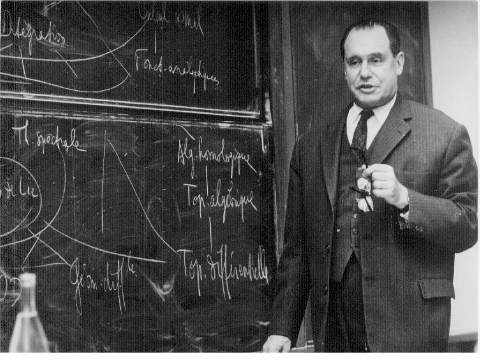
Le Colloquium a lieu le Lundi à en salle de conférences du LJAD
Accès
au laboratoire J.A. Dieudonné
VACANCES
Exposés passés
Février
| Mercredi 15 Février |
|
Olivier Faugeras (INRIA) |
Représentations sobres de grands ensembles de neurones
|
Résumé
Le cerveau humain contient plus de 100 milliards de neurones, chacun d'entre eux étant connecté par des synapses à quelques dizaines voire quelques centaines de milliers de voisins. L'étude mathématique de ces populations s'appuie sur les systèmes d'équations différentielles stochastiques qui permettent d'exprimer leur dynamique temporelle et son caractère stochastique. Pour rendre compte des phénomènes multi-échelles qui apparaissent au sein de ces populations les chercheurs en neuroscience mathématique tentent de développer des méthodes de champ moyen qui permettent d'aboutir à des représentations de l'activité neuronale plus compactes à des échelles méso- et macroscopiques. Je présenterai deux exemples de telles méthodes, une première inspirée des travaux de Sompolinsky, Ben Arous et Guionnet dans laquelle l'aléa des connections synaptiques est représenté par des variables aléatoires et une seconde, inspirée des travaux de McKean, Tanaka et Sznitman dans laquelle il est représenté par des processus stochastiques. J'indiquerai pour finir quelques directions de recherche futures.
|
Mars
| Lundi 5 Mars |
|
Robert McCann (University of Toronto) |
New perspectives and regularity results for optimal transportation
|
Résumé
The Monge-Kantorovich optimal transportation problem is to pair producers with consumers so as to minimize a given transportation cost. When the producers and consumers are modeled by probability densities on two given manifolds or subdomains, it is interesting to try to understand the structure of the optimal pairing as a subset of the product manifold. We first explain how topological features of the cost function yield rectifiability of this subset (meaning it is contained a Lipschitz submanifold of appropriate dimension). We also recall how, following work of Caffarelli, Delanoe and Urbas on the quadratic cost, Ma, Trudinger and Wang found geometrical conditions on a general cost which guarantee the subset is the graph a diffeomorphism, assuming both mass distributions are smooth. We finish by explaining a conclusion which persists under a weaker hypotheses: namely that the optimal map remains a \(C^\alpha_{loc}\) homeomorphism if the mass distributions are merely bounded above and below on domains with suitable geometry. The Hoelder exponent \(\alpha\) turns out to be uniform among (A3w) costs, depending only on the bounds for the distributions. This last result is joint work with Alessio Figalli and Young-Heon Kim.
|
Avril
| Lundi 16 Avril |
|
Clint McCrory (University of Georgia, Athens) |
Topology of smooth algebraic varieties -- real and complex
|
Résumé
By Hironaka's resolution of singularities every smooth real or complex algebraic variety X has a nice smooth compactification Y. The topology of the inclusion of X in Y can be used to define natural subgroups of the homology of X that do not depend on the choice of compactification. For a complex variety these subgroups comprise Deligne's weight filtration (1970), and for a real variety we obtain a new filtration analogous to Deligne's. I will give elementary descriptions of these constructions and some simple examples.
|
Mai
| Mardi 29 Mai |
|
Richard Hain (Duke University) |
Morse theory and mapping class groups in low genus
|
Résumé
This talk will be a gentle introduction to Morse theory and its applications to understanding mapping class groups in low genus. Morse theory is a tool for understanding topological spaces. Mapping class groups are groups of topological symmetries of a compact orientable surface. They occur as fundamental groups of moduli spaces of curves. After reviewing classical Morse theory, I will introduce the main ideas of stratified Morse theory, a generalization of classical Morse theory developed by Goresky and MacPherson in the 1980s to study singular spaces. The talk will conclude with several examples how stratified Morse theory can be used to prove results about mapping class groups in low genus.
|
Juin
| Lundi 25 Juin |
|
Alexandru Buium (Albuquerque, New Mexico et Max-Planck Institut) |
Differential equations satisfied by numbers
|
Résumé
The analogies between functions and numbers proved to be one of the most fruitful source of ideas in number theory.
One can therefore ask: is there an analog of differential calculus in which functions are replaced by numbers?
In particular is there a derivative of 23 with respect to 7? And does 23 (or its square or cube root, etc.)
satisfy remarkable differential equations with respect to the "variable" 7?
Also, provided one has definitions for these concepts, can one apply
such ideas to prove anything new in number theory/diophantine geometry?
The answer to all these questions is YES and the talk is devoted to explaining how this comes about.
|
Archives du séminaire:
Organisation: A.Dimca (écrire), V.Kostov (écrire), M.Ribot(écrire) et C.Scheid(écrire)
